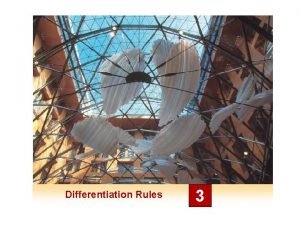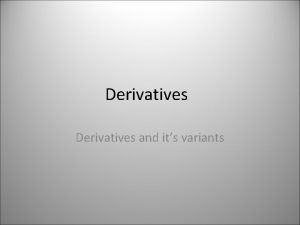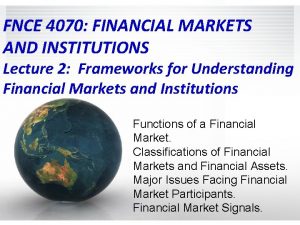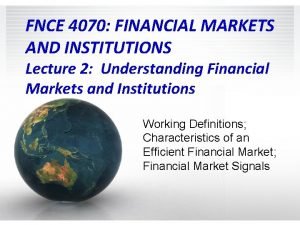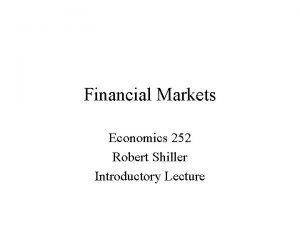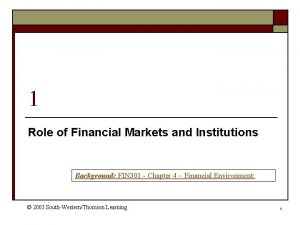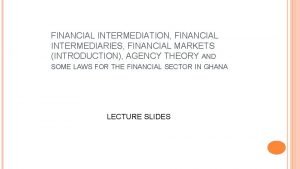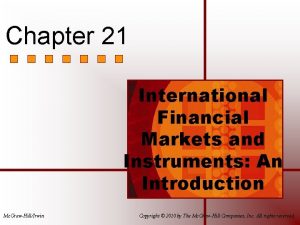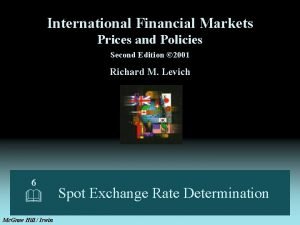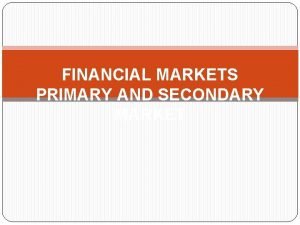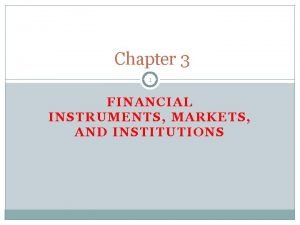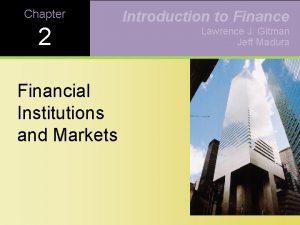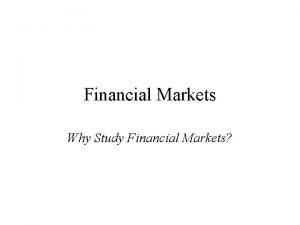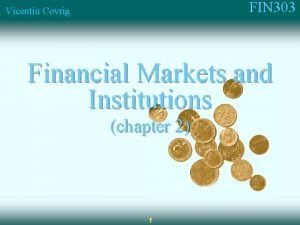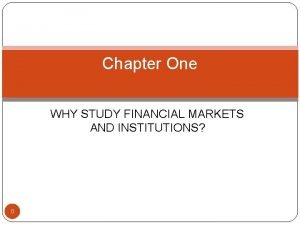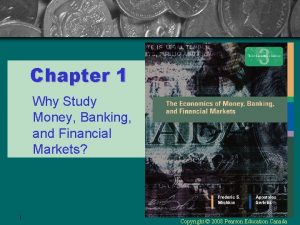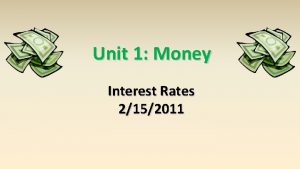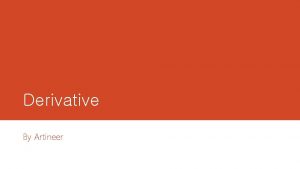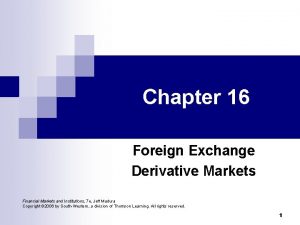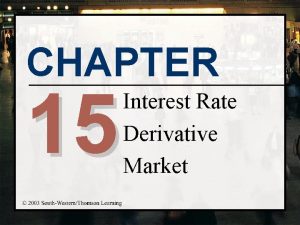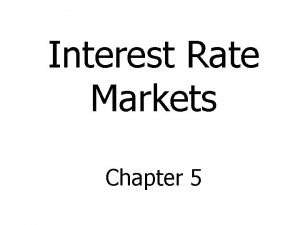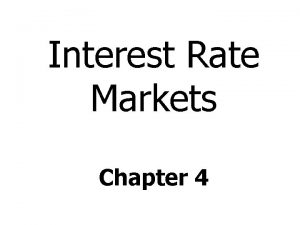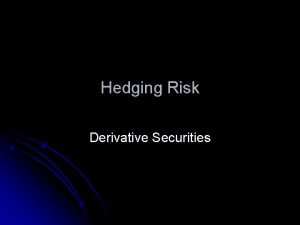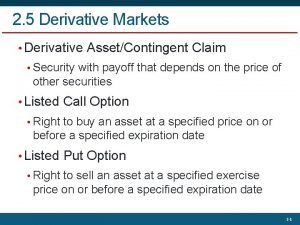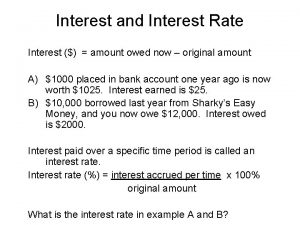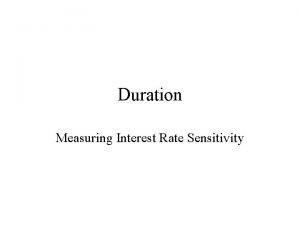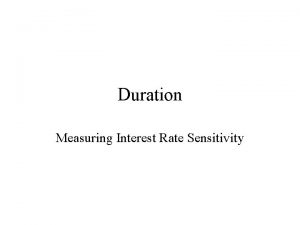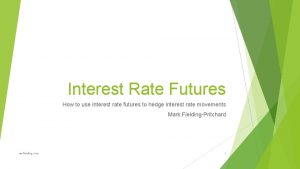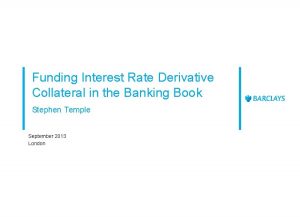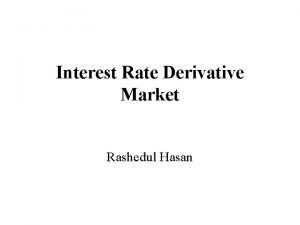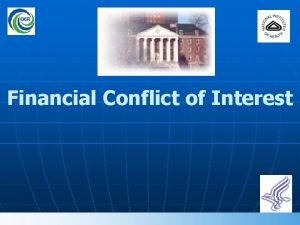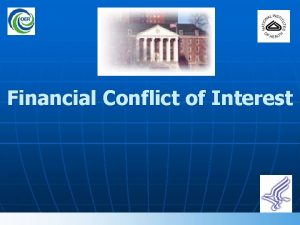Chapter 15 Interest Rate Derivative Markets Financial Markets







































- Slides: 39

Chapter 15 Interest Rate Derivative Markets Financial Markets and Institutions, 7 e, Jeff Madura Copyright © 2006 by South-Western, a division of Thomson Learning. All rights reserved. 1

Chapter Outline n n n n Background Participation by financial institutions Types of interest rate swaps Risks of interest rate swaps Pricing interest rate swaps Factors affecting the performance of interest rate swaps Interest rate caps, floors, and collars Globalization of swap markets 2

Background n An interest rate swap is an arrangement whereby one party exchanges one set of interest payments for another ¨ n e. g. , fixed-rate payments are exchanged for floating-rate payments The provisions of a swap include: ¨ ¨ ¨ The notional principal The fixed interest rate The formula and type of index to determine the floating rate The frequency of payments The lifetime of the swap 3

Background (cont’d) n n Amounts owed are typically netted out so that only the net payment is made The market for swaps is facilitated by over-the-counter trading ¨ n Swaps are less standardized than other derivatives Swaps became popular in the early 1980 s because of large fluctuations in interest rates e. g. , financial institutions traditionally had more interest rate-sensitive liabilities than assets and were adversely affected by rising interest rates ¨ e. g. , some foreign financial institutions had access to long-term fixed rate funding but used funds primarily for floating rate loans ¨ By engaging in an interest rate swap, both institutions can reduce their exposure to interest rate risk (see next slide) ¨ 4

Background (cont’d) n A U. S. financial institutions could send fixed-rate payments to a European financial institution in exchange for floating-rate payments If interest rates rise, the U. S. financial institution receives higher interest payments from the floating-rate portion, which helps to offset the rising cost of obtaining deposits ¨ If interest rates decline, the European institution provides lower interest payments in the swap, which helps to offset the lower interest payments received on its floating-rate loans ¨ The U. S. institution forgoes the potential benefits from a decline in interest rates ¨ The European institution forgoes the potential benefits from an increase in interest rates ¨ 5

Background (cont’d) n A primary reason for the popularity of swaps is market imperfections ¨A lack of information about foreign institutions and convenience encourages individual depositors to place deposits locally n Swaps are sometimes used for speculative purposes ¨ e. g. , a firm could engage in a swap to benefit from rising interest rates even if its operations are not exposed to interest rate movements 6

Participation by Financial Institutions n n Financial institutions that are exposed to interest rate movements commonly engage in swaps to reduce interest rate risk Some commercial banks and securities firms serve as intermediaries by matching up firms and facilitating the swap arrangements ¨ Charge n fees and may provide credit guarantees Some institutions act as dealers in swaps ¨ The financial institution takes the counterparty position in order to serve a client 7

Participation by Financial Institutions Financial Institution Participation in Swap Market Commercial banks ØEngage in swaps to reduce interest rate risk ØServe as an intermediary by matching up two parties in a swap ØServe as a dealer by taking the counterparty position to accommodate a party the desires to engage in a swap S&Ls and savings banks ØEngage in swaps to reduce interest rate risk Finance companies ØEngage in swaps to reduce interest rate risk Securities firms ØServe as an intermediary by matching up two parties in a swap ØServe as a dealer by taking the counterparty position to accommodate a party that desires to engage in a swap Insurance companies ØEngage in swaps to reduce interest rate risk Pension funds ØEngage in swaps to reduce interest rate risk 8

Types of Interest Rate Swaps n Plain vanilla swaps ¨ In a plain vanilla swap (fixed-for-floating swap), fixed-rate payments are periodically exchanged for floating-rate payments ¨ Consider two scenarios: A consistent rise in market interest rates n A consistent decline in market interest rates n 9

Types of Interest Rate Swaps (cont’d) n Plain vanilla swaps (cont’d) Rising Interest Rates Level of Interest Payments Declining Interest Rates Floating Inflow Payments Fixed Outflow Payments Floating Inflow Payments End of Year 10

Using A Plain Vanilla Swap Bruny Bank has negotiated a plain vanilla swap in which it will exchange fixed payments of 8 percent for floating payments equal to LIBOR plus 1 percent at the end of each of the next four years. Assume that the notional principal is $100 million. Fill in the table on the next slide for the two scenarios of rising and falling interest rates. 11

Scenario 1 Year 1 LIBOR 2 7. 0% 3 7. 5% 4 8. 5% 9. 5% Floating rate received Fixed rate paid Swap differential Net dollar amount received Scenario 2 Year 1 LIBOR 2 6. 5% 3 6. 0% 4 5. 0% 4. 5% Floating rate received Fixed rate paid Swap differential Net dollar amount received 12

Scenario 1 Year 1 2 3 4 LIBOR 7. 0% 7. 5% 8. 5% 9. 5% Floating rate received 8. 0% 8. 5% 9. 5% 10. 5% Fixed rate paid 8. 0% Swap differential 0. 0% 0. 5% 1. 5% 2. 5% $0 $500 K $1. 5 M $2. 5 M Net dollar amount received Scenario 2 LIBOR Year 1 2 3 4 6. 5% 6. 0% 5. 0% 4. 5% Floating rate received 7. 5% 7. 0% 6. 0% 5. 5% Fixed rate paid 8. 0% Swap differential – 0. 5% – 1. 0% – 2. 5% –$500 K –$1 M –$2. 5 M Net dollar amount received 13

Types of Interest Rate Swaps (cont’d) n Forward swaps ¨A forward swap involves an exchange of interest payments that does not begin until a specified future point in time Useful for institutions that expect to be exposed to interest rate risk at a future point in time n The fixed rate on a forward swap may differ from the fixed rate on a swap beginning immediately n ¨ Institutions may be able to negotiate a fixed rate today that is less than the expected fixed rate on a swap negotiated in the future 14

Types of Interest Rate Swaps (cont’d) n A forward swap beginning in year 3: Rising Interest Rates Declining Interest Rates Level of Interest Payments Floating Inflow Payments Fixed Outflow Payments Floating Inflow Payments 0 3 End of Year 0 3 15

Types of Interest Rate Swaps (cont’d) n Callable swaps ¨A callable swap provides the party making the fixed payments with the right to terminate the swap prior to its maturity n Allows the fixed-rate payer to avoid exchanging future interest payments if it desires ¨ The fixed-rate payer pays a premium in the form of a higher interest rate than without the call feature ¨ Callable swaps are an example of swaptions 16

Types of Interest Rate Swaps (cont’d) n A callable swap terminated in year 3: Rising Interest Rates Declining Interest Rates Level of Interest Payments Floating Inflow Payments Fixed Outflow Payments Floating Inflow Payments End of Year 3 17

Types of Interest Rate Swaps (cont’d) n Putable Swaps ¨A putable swap provides the party making the floating-rate payments with a right to terminate the swap n The floating-rate payer pays a premium in the form of a higher floating rate ¨ Extendable n n swaps An extendable swap contains a feature that allows the fixedfor-floating party to extend the swap period The terms of an extendable swap reflect a price paid for the extendability feature 18

Types of Interest Rate Swaps (cont’d) n A putable swap terminated in year 3: Rising Interest Rates Declining Interest Rates Level of Interest Payments Floating Inflow Payments Fixed Outflow Payments Floating Inflow Payments 3 End of Year 19

Types of Interest Rate Swaps (cont’d) n An extandable swap after year 8: Rising Interest Rates Declining Interest Rates Level of Interest Payments Floating Inflow Payments Fixed Outflow Payments Floating Inflow Payments 8 End of Year Extend 8 Don’t Extend 20

Types of Interest Rate Swaps (cont’d) n Zero-coupon-for-floating swaps ¨ In a zero-coupon-for-floating swap: n n The fixed-rate payer makes a single payment at the maturity date The floating-rate payer makes periodic payments throughout the swap period ¨ An institution that expects interest rates to increase would prefer to be the fixed-rate payer ¨ An institution that expects interest rates to decline would prefer to be the floating-rate payer 21

Types of Interest Rate Swaps (cont’d) n A zero-coupon-for-floating swap: Rising Interest Rates Level of Interest Payments Declining Interest Rates Single Fixed Outflow Payment Floating Inflow Payments End of Year 22

Types of Interest Rate Swaps (cont’d) n Rate-capped swaps A rate-capped swap involves the exchange of fixed-rate payments for floating-rate payments that are capped ¨ The floating-rate payer pays an up-front fee for this feature ¨ The fixed-rate payer may allow the cap if it believes interest rates will not exceed the cap and receives the up-front fee ¨ n Equity swaps An equity swap involves the exchange of interest payments linked to the degree of change in a stock index ¨ Appropriate for portfolio managers of insurance companies or pension funds that are managing stocks and bonds ¨ 23

Types of Interest Rate Swaps (cont’d) n A rate-capped swap: Rising Interest Rates Declining Interest Rates Level of Interest Payments Cap level Floating Inflow Payments Fixed Outflow Payments Floating Inflow Payments End of Year 24

Types of Interest Rate Swaps (cont’d) n Other types of swaps ¨ Use n of swaps to accommodate financing preferences Some swaps are combined with other transactions such as the issuance of bonds ¨ ¨ n Corporate borrowers may be able to get a more attractive rate when using floating-rate debt Other corporate borrowers may prefer to borrow at a floatingrate but find it advantageous to borrow at a fixed rate Financial intermediaries may match up participants and sometimes assume the default risk involved 25

Types of Interest Rate Swaps (cont’d) n Other types of swaps (cont’d) ¨ Tax advantage swaps n Firms with expiring tax loss carryforwards from previous years can engage in a swap that calls for receipt of a large up-front payment with less favorable terms over time ¨ n Firms would realize an immediate gain and possible losses in future years Firms expecting large future losses but large gains this year could engage in a swap requiring a large payment now and more favorable terms over time 26

Risks of Interest Rate Swaps n n Basis risk is the risk that the interest rate of the index used for an interest rate swap will not move perfectly in tandem with the floating-rate instruments of the parties involved in the swap Default risk is the risk that a firm involved in the swap will not meet its payment obligations ¨ Usually not pronounced because the nondefaulting party will discontinue its payments n Sovereign risk reflects potential adverse effects resulting from a country’s political conditions ¨ e. g. , the government may take over one of the parties of the swap 27

Pricing Interest Rate Swaps n Prevailing market interest rates The fixed rate in the swap is influenced by supply and demand conditions for funds ¨ Generally, the interest rates of the swap reflect the prevailing interest rates at the time of the agreement ¨ n Availability of counterparties When many counterparties are available, a more attractive deal might be negotiated ¨ Availability of counterparties can change in response to economic conditions ¨ n Credit and sovereign risk ¨ e. g. , a firm that desires a fixed-for-floating swap will require a lower fixed rate applied to its outflow payments if the credit risk or sovereign risk of the counterparty is high 28

Factors Affecting the Performance of Interest Rate Swaps n n The most important are forces that influence interest rate movements The impact of the underlying forces depends on the party’s swap position ¨ n e. g. , strong economic growth can increase rates, which is beneficial for a party that is swapping fixed-rate payments for floating-rate payments but not for the counterparty Indicators monitored by participants in the swap market Economic growth indicators ¨ Inflation indicators ¨ Indicators of government borrowing ¨ 29

Interest Rate Caps, Floors, and Collars n Interest rate caps ¨ An interest rate cap offers payments in periods when a specified interest rate index exceeds a specified ceiling (cap) interest rate n Payments are based on the amount by which the interest rate exceeds the ceiling Typical purchasers are institutions that are adversely affected by rising interest rates ¨ The seller of an interest rate cap received an up-front fee and is obligated to provide period payments as needed ¨ Typical sellers are institutions that expect interest rates to decline or remain stable ¨ Commercial banks and securities firms serve as dealers and/or brokers for interest rate caps ¨ 30

Using An Interest Rate Cap Bungee Bank purchases a three-year cap for a fee of 3 percent of notional principal valued at $50 million, with an interest rate ceiling of 10 percent. The agreement specified LIBOR to be used to represent the prevailing market interest rate. LIBOR is currently 8 percent and is expected to increase by 1 percent in each of the next three years. Fill in the table below. End of Year 0 LIBOR 1 2 3 9. 0% 10. 0% 11. 0% Interest rate ceiling LIBOR’s percent above ceiling Payments received Fee paid 31

Using An Interest Rate Cap (cont’d) End of Year 1 2 3 9. 0% 10. 0% 11. 0% 10. 0% LIBOR’s percent above ceiling 0% 0% 1. 0% Payments received $0 $0 $500, 000 0 LIBOR Interest rate ceiling Fee paid $1, 500, 000 32

Interest Rate Caps, Floors, and Collars (cont’d) n Interest rate floors ¨ An interest rate floor offers payments when a specified interest rate index falls below a specified floor rate n Payments are based on the amount by which the interest rate falls below the floors rate Interest rate floors can be used to hedge against lower interest rates ¨ Sellers of interest rate floors receive an up-front fee and are obligated to provide periodic payments as needed ¨ Commercial banks and securities firms serve as dealers and/or brokers for interest rate caps ¨ 33

Using An Interest Rate Floor Purage Bank purchases a three-year floor for a fee of 3 percent of notional principal valued at $50 million, with an interest rate floor of 8 percent. The agreement specified LIBOR to be used to represent the prevailing market interest rate. LIBOR is currently 6 percent and is expected to increase by 1 percent in each of the next three years. Fill in the table below. End of Year 0 LIBOR 1 2 3 7. 0% 8. 0% 9. 0% Interest rate floor LIBOR’s percent below floor Payments received Fee paid 34

Using An Interest Rate Floor (cont’d) End of Year 1 2 3 LIBOR 7. 0% 8. 0% 9. 0% Interest rate floor 8. 0% LIBOR’s percent below floor 1% 0% 1. 0% $500, 000 $0 Payments received Fee paid 0 $1, 500, 000 35

Interest Rate Caps, Floors, and Collars (cont’d) n Interest rate collars ¨ An interest rate collar involves the purchase of an interest rate cap and the simultaneous sale of an interest rate floor n The fee received from selling the floor can be used to pay the fee for purchasing the cap ¨ Institutions wishing to hedge against rising interest rates purchase collars n If interest rates rise as expected and remain above the floor, the institution will not have to make payments 36

Globalization of Swap Markets n n Foreign financial institutions and manufacturing corporations from various counties that are exposed to interest rate risk engage in interest rate swaps Swaps are executed in various countries and denominated in many different currencies ¨ n n Dollar-denominated swaps account for about half the value of all swaps outstanding Banks and securities firms that serve as intermediaries have a globalized network of subsidiaries A barrier to the global swap market is the lack of information about participants based in other countries 37

Globalization of Swap Markets (cont’d) n Currency swaps ¨A currency swap is an arrangement whereby currencies are exchanged at specified exchange rates and at specified intervals n A combination of currency futures contracts ¨ Currency swaps are commonly used by firms to hedge their exposure to exchange rate fluctuations ¨ Some currency swaps allow for early termination ¨ Using currency swaps to hedge bond payments n Currency swaps can be used in conjunction with bond issues to hedge foreign cash flows 38

Globalization of Swap Markets (cont’d) n Risks of currency swaps ¨ Basis risk can exist if the firm cannot obtain a currency swap on the currency it is exposed to and uses a related currency instead ¨ Credit risk reflects the possibility that the counterparty may default on its obligation ¨ Sovereign risk reflects the possibility that a county may restrict the convertibility of a particular currency 39
 Real vs nominal interest rate
Real vs nominal interest rate Cap rate interest rate relationship
Cap rate interest rate relationship Why study financial markets and institutions?
Why study financial markets and institutions? Nominal rate
Nominal rate Compound interest multiplier
Compound interest multiplier Rate of change differentiation
Rate of change differentiation Financial derivative definition
Financial derivative definition Derivative instrument
Derivative instrument Participants in money market
Participants in money market Classification of financial markets
Classification of financial markets Classification of financial markets
Classification of financial markets Financial markets shiller
Financial markets shiller Classification of financial markets
Classification of financial markets Classification of financial markets
Classification of financial markets Role of financial markets
Role of financial markets Financial markets and institutions ppt
Financial markets and institutions ppt Financial intermediary
Financial intermediary Are financial markets efficient
Are financial markets efficient International financial markets and instruments
International financial markets and instruments Capital markets and financial intermediation
Capital markets and financial intermediation Levich international financial markets
Levich international financial markets Levich international financial markets
Levich international financial markets Primary and secondary financial markets
Primary and secondary financial markets Efficient capital allocation
Efficient capital allocation Chartered wealth manager cisi
Chartered wealth manager cisi Foreign exchange and international financial markets
Foreign exchange and international financial markets Basic flow of funds through the financial system
Basic flow of funds through the financial system Madura j. financial markets and institutions
Madura j. financial markets and institutions Pilbeam k. finance and financial markets
Pilbeam k. finance and financial markets Finance and financial markets keith pilbeam
Finance and financial markets keith pilbeam Classification of financial markets
Classification of financial markets Madura j. financial markets and institutions
Madura j. financial markets and institutions Fractals in financial markets
Fractals in financial markets Well functioning financial markets
Well functioning financial markets Why study financial markets and institutions
Why study financial markets and institutions Savers and investors role in financial markets
Savers and investors role in financial markets Why study money banking and financial markets
Why study money banking and financial markets Why study money banking and financial markets
Why study money banking and financial markets Why study financial markets
Why study financial markets Interest rate effect
Interest rate effect





